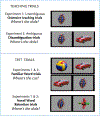Fast mapping, slow learning: disambiguation of novel word-object mappings in relation to vocabulary learning at 18, 24, and 30months
- PMID: 23063233
- PMCID: PMC6590692
- DOI: 10.1016/j.cognition.2012.08.008
Fast mapping, slow learning: disambiguation of novel word-object mappings in relation to vocabulary learning at 18, 24, and 30months
Abstract
When hearing a novel name, children tend to select a novel object rather than a familiar one, a bias known as disambiguation. Using online processing measures with 18-, 24-, and 30-month-olds, we investigate how the development of this bias relates to word learning. Children's proportion of looking time to a novel object after hearing a novel name related to their success in retention of the novel word, and also to their vocabulary size. However, skill in disambiguation and retention of novel words developed gradually: 18-month-olds did not show a reliable preference for the novel object after labeling; 24-month-olds reliably looked at a novel object on Disambiguation trials but showed no evidence of retention; and 30-month-olds succeeded on Disambiguation trials and showed only fragile evidence of retention. We conclude that the ability to find the referent of a novel word in ambiguous contexts is a skill that improves from 18 to 30months of age. Word learning is characterized as an incremental process that is related to - but not dependent on - the emergence of disambiguation biases.
Copyright © 2012 Elsevier B.V. All rights reserved.
Figures






References
-
- Anglin JM (1993). Vocabulary development: A morphological analysis. Monographs for the Society for Research in Child Development, 58 (Serial No. 238).
-
- Baillargeon R, & Graber M (1987). Where’s the rabbit? 5.5-month-old infants’ representation of the height of a hidden object. Cognitive Development, 2, 375–392.
-
- Baldwin D (1991). Infants’ contribution to the achievement of joint reference. Child Development, 62, 874–890. - PubMed
-
- Baldwin D (1993). Infants’ ability to consult the speaker for clues to word reference. Journal of Child Language, 20, 395–395. - PubMed
Publication types
MeSH terms
Grants and funding
LinkOut - more resources
Full Text Sources
Other Literature Sources
Medical

